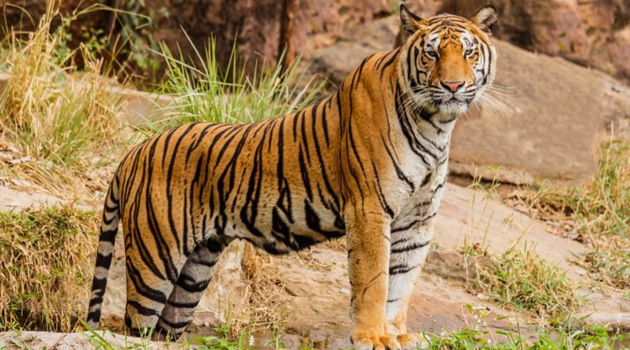
Nepal’s tiger population almost double in a decade

–Ram Sharan Tamang
Latest count puts the number at 235
Kathmandu–Tigers in Nepal have become more conspicuous despite the constant threats from poachers, receding forest areas and development projects infringing upon their habitat. The latest estimate of a survey released on Sunday shows that the adult tiger population in the country has reached to 235, which is a 19 percent increment from the last census in 2013.
The 2018 survey, which was made public on the occasion of National Conservation Day on September 23, shows that tiger conservation efforts made by the government in collaboration with non-governmental organizations and donors are hitting the mark.
According to the Department of National Parks and Wildlife Conservation (DNPWC), Chitwan National Park boasts of the highest concentration of tigers in the country with 93 adult tigers. Likewise, there are 87 tigers in Bardiya National Park, 21 in Banke National Park, 18 in Parsa National Park and 16 in Shuklaphanta National Park.
Prior to the latest survey, Nepal was relying on 2013 census which had tallied the number of total tigers in the country at 198. Comparison between the two surveys shows that the population of tigers has increased significantly in Parsa, Banke and Bardiya national parks while it has decreased in Chitwan and Shuklaphanta national parks.
The number of tigers in Banke has increased by five times while its population doubled in Parsa. Although Chitwan still hosts the highest number of tigers in the country, the population there has dwindled by 27 since the 2013 survey.
However, Ghanashyam Gurung, country representative of World Wildlife Fund (WWF) Nepal, said the dwindling tiger population in CNP is not a very serious matter of concern as tigers are known to traverse borders and the dwindling population in one area is offset by increase in its population in the other areas.
Right on track
With the unveiling of the latest tiger count, Nepal is on track to become the first country to double its tiger population in accordance with the ambitious TX2 goal of Global Tiger Recovery Programme, said WWF Nepal, which has long been providing financial and technical supports in the government’s wildlife conservation efforts.
During the world’s first tiger summit held in St Petersburg in 2010, leaders of 13 tiger-range countries including Nepal endorsed the action plan to strengthen tiger conservation efforts, crack down on poachers and maintain a thriving population of the iconic animal of the Asian tropical forests.
In the summit, Nepal committed to double its tiger population from 121 (2009 national tiger census) to more than 242 by 2022 – the next Chinese year of the tiger. Nepal is now just seven tigers away from meeting the ambitious aim, that too four years ahead of the agreed time frame.
“We are on track to fulfill our 2010’s commitment of doubling tiger’s population by 2022,” said Gopal Prasad Bhattarai, deputy director general of the DNPWC. “This prospect has made us very excited.”
WWF’s country representative Gurung said the success is largely due to the highest level of political commitment given to tiger conservation and support from locals from the ground level.
“There are still many challenges in wildlife conservation. We should continue focusing on minimizing human-wildlife conflicts and better our efforts in wildlife management,” he added.
Nepal is not the only country to enjoy success in tiger conservation. International media outlets have reported success of tiger conservation efforts of other countries as well, notably in India and Russia.
Tiger is considered as the most endangered big cat, with a world population as few as 3,200 in 2010. After a century of decline, the number of wild tigers had risen to 3,890 in 2016 tally published during the third Asia Ministerial Conference on Tiger Conservation. The success is largely attributed to enhanced protection and conservation. (Republica)